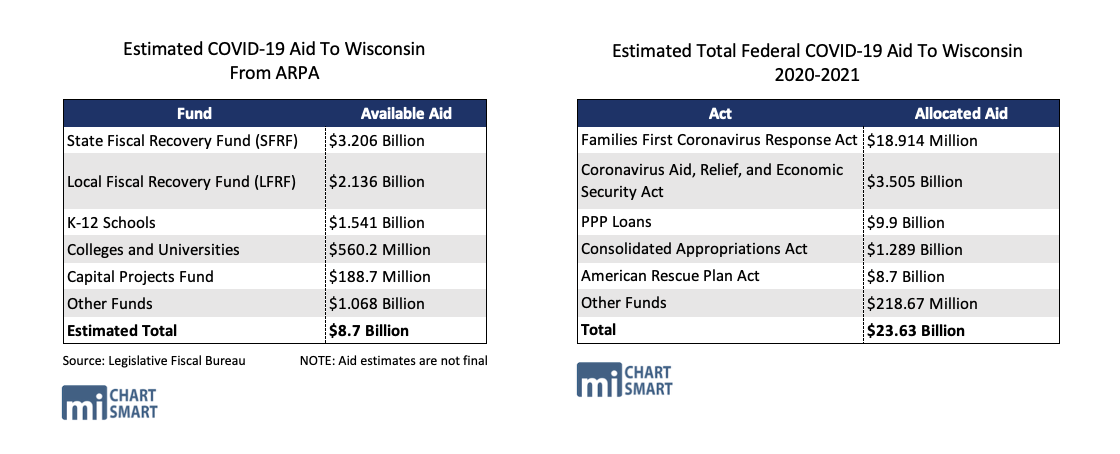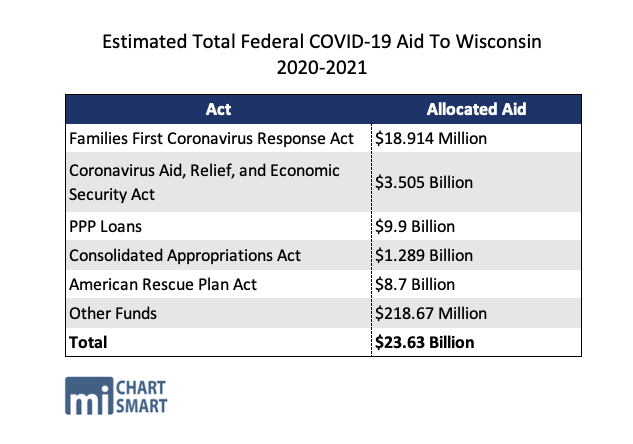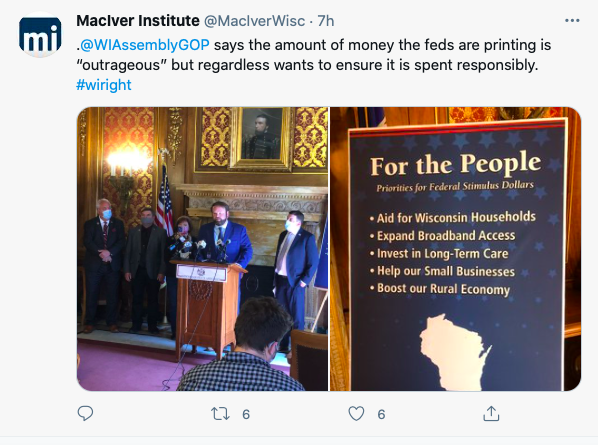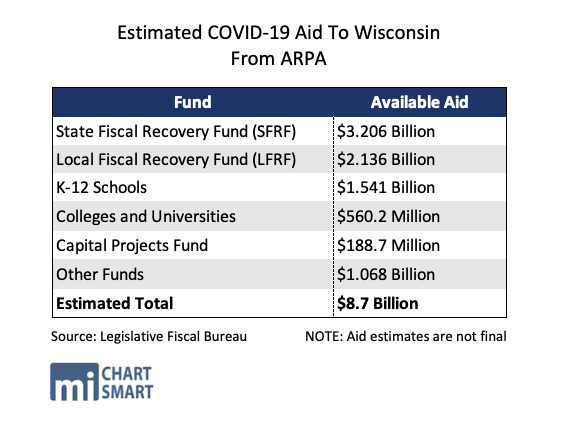
Mar. 31, 2021
By MacIver Staff
Under the recently passed American Rescue Plan Act (ARPA), the state of Wisconsin and other local units of government will receive another massive round of federal aid to ostensibly battle COVID-19 and help our economy recover from the government-imposed shutdown of our businesses and our way of life.
While all the details are not yet final, we are starting to hear from Governor Tony Evers and members of the Legislature about how they would spend the billions of dollars in new federal aid.
Wisconsin’s nonpartisan Legislative Fiscal Bureau (LFB) estimates the state as a whole could receive an additional $8.7 billion in aid from the package. The total amount of federal aid that will be sent to Wisconsin may not be known for some time. Final numbers won’t be known until the US Treasury releases a guidance document about how ARPA will be implemented and all details of the legislation are ironed out.
The estimated $8.7 billion does not include the Biden stimulus checks sent directly to Wisconsinites and it does not include another round of federal aid that will flow into Wisconsin’s unemployment insurance program.
Right now, it appears Governor Evers has control over at least $3.2 billion of the ARPA pot.
The ARPA stimulus package is broken down into categories:
- State Fiscal Recovery Fund (SFRF) – Wisconsin State Government will receive an estimated $3.206 billion from the SFRF. SFRF funds can be used to pay for the ongoing COVID-19 fight, to replace lost government revenue, for water, sewer and broadband infrastructure, for “premium pay” of up to $13 per hour for essential workers and “the transportation of passengers or cargo.” According to the ARPA legislation, state governments are prohibited from using SFRF monies for tax cuts and government pension fund payments.
- Local Fiscal Recovery Fund (LFRF) – County and municipal governments in Wisconsin will receive a total of $2.136 billion from the LFRF. Funds from the LFRF can be used for the same purposes as the SFRF. Like the SFRF, LFRF funds cannot be used for pension fund payments. However, it appears that LFRF funds can be used for tax cuts.
- K-12 Schools in Wisconsin are set to receive an additional $1.541 billion in ARPA funds that will be sent through the original Elementary and Secondary School Emergency Relief Fund. Wisconsin K12 schools have already received $860.9 million through this fund from the Coronavirus Aid Relief and Economic Security Act (CARES Act) and the Consolidated Appropriations Act (CAA). In addition to the new $1.541 billion, the Governor will have control over an additional $67 million for schools. The $67 million will be handed out through the “Governor Emergency Education Relief Fund” and Governor Evers will decide how this pot of money will be spent.
- Wisconsin colleges and universities are expected to receive another $560 million in ARPA funds through the Higher Education Emergency Relief Fund. These funds will be used to offset costs incurred as a result of the virus and will also be used for financial aid grants to certain students.
- Capital Projects Fund – Wisconsin’s state and tribal governments will receive an estimated $188.7 million to fund capital projects in response to the pandemic.
In addition to the state and municipality spending, the stimulus package provides billions of dollars to unemployment insurance, welfare boosts, transportation, humanities, environmental grants and more.
The ARPA funds come on the back of the previous $5 billion in federal aid that Wisconsin received from the CARES Act (Coronavirus Aid Relief and Economic Security Act) and the CCA (Consolidated Appropriations Act). Additionally, Wisconsin businesses have received $9.9 billion in forgivable federal loans distributed under the Paycheck Protection Program. All told, the Federal Government has sent over $23 billion in COVID-19 aid to Wisconsin. By comparison, Wisconsin’s entire 2019-2021 two-year state budget spent $84 billion all funds.
Earlier this week, Governor Evers announced his plan for how he will spend $2.5 billion of the $3.2 billion in ARPA funds granted to his Administration. He says he will earmark:
- $50 million for the tourism industry
- $600 million to “support businesses”
- $200 million for infrastructure, with “a significant portion” set aside for broadband expansion
- $500 million for Wisconsin’s statewide pandemic response
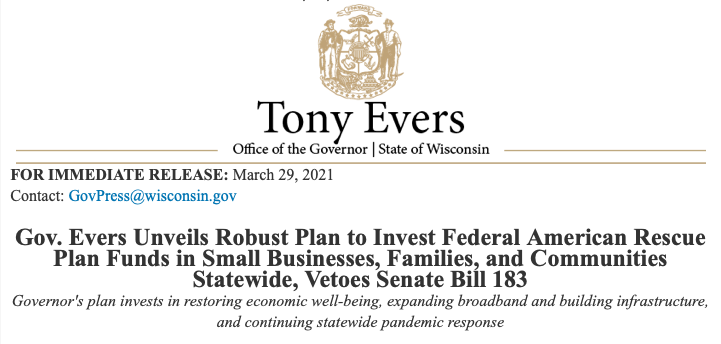
In the same message, Evers also announced his veto of SB 183, a bill that would have required the Governor to submit a plan for ARPA aid spending to the Joint Committee on Finance for approval. Evers said his veto was because “it is critical to get the federal COVID-19 relief funds in the hands of Wisconsinites and businesses that need it as quickly as possible, and I have concerns that the process outlined in the bill will prevent that from happening.”
Assembly Republicans presented their own priorities for the ARPA $3.2 billion discretionary spending today.
JFC Co-Chair Mark Born recommended that the Governor spend $1 billion of his discretionary funds on assistance to homeowners by sending out checks directly to property owners. Checks would be worth 10% of the homeowner’s property taxes.
Rep. Born proposed a $500 million grant program to expand broadband access. Governor Evers recommended a “significant portion” of the $200 million in infrastructure funds from ARPA to go toward broadband expansion. Evers’ state budget proposal would also spend $204 million on broadband expansion.
Assembly Republicans also suggested that a portion of Evers’ discretionary ARPA spending go toward long-term care facilities. This comes after DHS recently revealed that 45% of COVID-19 deaths in Wisconsin were associated with long-term care facilities. Assembly Republicans noted that less than 10% of the Governor’s discretionary spending from the CARES Act was allocated to long-term care facilities last year.
MacIver will provide further updates as we learn more about the newest round of federal COVID-19 spending in Wisconsin.
